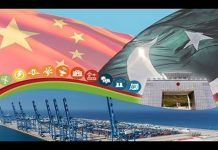Prior to “Open-up” Policy in 1979, China was one of the poorest countries in the world. Its per capita income was $182, less than one third of the average in Sub-Saharan African countries — the poorest continent in the world. Its trade volume was only 9.5% of the GDP, which means that more than 90% of the economy was a closed economy, and had no linkages with the global economy either. I intend to argue in this article as to what are those factors through which China has achieved growth by leaps and bounds after the 1979 “opening-up” to the rest of the world. It is also interesting to find out the underlying reasons for the bottled economy prior to the 1979 era.
It is worth mentioning that since 1979 to 2014; the average annual growth rate was 9.7% per year. This accentuation is the highest in the world and lasted the longest in the human history. China’s trade grew at a rate of 16.3% per year over these 36 years. Therefore, with this rapid growth and “opening up” of the economy, by 2009 China overtook Japan thus ranked itself the second largest economy in the world. With China’s economic ascendance, its exports overtook Germany in 2010 and turned out to be the largest exporter in the world, also and in 2013 the China’s trade volume excessed the US and became the largest trading nation in the world. In terms of purchasing power parity, China became the world’s largest economy in 2015, leaving far behind the US. This 36 years of Chinese economic boom resulted in riding poverty upwards of about 680 million populations which is one of the major by-products of economic development.
One can say that it’s because of economic reforms and economic transition. But in 1980s, 1990s, almost all of the developing countries adopted the Washington Consensus on liberalization (remove protections and subsides) to reform to open-up their economies and most of them collapsed, were stagnant and hit by crisis from time to time. Similarly, it is also understood that rapid economic growth is a modern phenomenon. Before the 18th century, almost every country had stagnant economic growth. Even for high-income countries in the 19th century for e:g many of the Western European countries, the historical data showed before the 18th century for them the average annual growth rate of per capita income was 0.05% per year. But, post WWII high income countries, average annual growth rate doubled from 1% per year to almost 2% per year. Such kind of dramatic changes happened due to Industrial Revolution, that resulted in accelerated technological innovation and a new stream of higher value-added industries appeared, labour productivity improved which led to high income.
However, the manufacturing technologies of developing countries are old and value addition to industry is low. Thus, in the process of industrial upgradation and technological innovations they have something called an advantage of backwardness because they can barrow, imitate and even can license the technology from high income countries and for those kinds of licensing, borrowing or imitation the cost of innovation and industrial upgrading would be much lower than inventing those kinds of technology or industries and the risk is also much smaller. Hence, if a developing country knows how to tap into that potential of the advantage of backwardness they can grow much faster than high-income countries.
But the inquisitiveness behind China’s overwhelming rise is a glaring question for the developing and under developing economies of the world. The answer is the ability to utilise the advantage of backwardness. The advantage of backwardness was the reason for the rapid economic growth up to 1979. Similar advantages have been there before 1979. So, how come before 1979, China’s economy was stagnant and the country was lying below the poverty line. The answer is quiet simple. In 1949 the socialist government took over and wanted to modernise its economy, but at that time the ideal modernisation was to catch up with the US and Britain. This means that at that time, China wanted to develop the most advanced modern industry or high tech industry immediately in the 1950s. If China wanted to develop such kind of industrial progress, they needed to re-invent the wheel. Therefore, they voluntarily gave up the potential of the advantage of backwardness for the said period. However, even today these modern industries are still under the patent protection of high-income countries. They had just invented that and most of those industries are still generating income related to the national security and strategic defence of those countries. Hence, the high-income countries would never transport those kinds of technologies to the rest of the world for their technological supremacy.
Secondly, high-tech industries are capital intensive. They require a lot of capital input. But China in the 1950s was a poor agrarian economy. Capital was not the advantage of China; instead it had an abundant supply of labour force. As a result in an open competitive market such industries were not consistent with China’s comparative advantages. Enterprises in those kinds of sectors were not viable in open competitive markets, unless the government protect them, subsidise them, and mobilize resources to invest in high-tech industrial sectors. As a result first there was some kind of misallocation of resources. China did not have comparative advantages in a capital intensive sector but China wisely mobilized all the resources to put into that sector. Although, despite China’s comparative advantage in the labour intensive sector it was unable to tap the potential and resources it had. Therefore, China was confronted against the problem of misallocation of resources. Since 1979 China started opening up or liberalised to develop that particular sector in which China had comparative advantage. This was the Light Manufacturing sector. They utilities their labour intensive industries to generate jobs for unemployed workers, and open-up a large domestic and international market that made a lot of profit. China accumulated capital through the model of Special Economic Zones. With capital accumulated and Foreign Direct Investment they upgraded the industry. In the process of industrial upgradation, China could benefit from the advantage of backwardness.
Thus the answer to the question, that why couldn’t China grow that fast before 1979? The reason being that it adopted wrong development strategy. Even if you have potential, a wrong strategy, misallocation of resources, and inadequate policy leads countries nowhere. The precedent set by China marks the fact that countries around the globe will only prosper, when they realize and focus the policy towards their comparative advantages.
The writer is a Research Associate at the Center of Excellence-China Pakistan Economic Corridor (CoE-CPEC) and a PhD Scholar at Pakistan Institute of Development Economics, Islamabad. Email: adnan.khan@cpec-centre.pk
Published in Pakistan Observer on 13th August 2017

 中文
中文 Urdu
Urdu











